Poland is a significant fruit and vegetable producer. Belarus remains the country's number one buyer. Poland is the Netherlands' fourth-largest buyer. But, it is also a net importing country.
In the past year, Poland imported 2.5 million tons of fresh fruit and vegetables. It exported 1.7 million tons. This makes Poland the tenth-largest importing country worldwide. It takes the 19th spot as an exporter. That is according to a Fruit&Vegetable Facts analysis.
Poland's imports rose slightly in 2020 but fell a little in early 2021. Eurostat states that Poland imported over 600,000 tons of fresh fruit and vegetables from the Netherlands last year. This made the Netherlands Poland's most important fresh fruit and vegetables supplier. With 576,000 tons, Spain was its second-largest supplier. Germany was 3rd with 318,00 tons.
Last year, Poland exported much less than previously. That was mainly due to the reduced export of its main product, apples. They also sold less of their second most important wholesale export product, mushrooms. Belarus has been the top Polish fresh fruit and vegetable buyer, by far, for years.
That dominant position has been eroded considerably. That is perhaps due to stricter compliance with the rules. In 2016, Poland exported 690,000 tons to Belarus. In 2019, it was still 350,000 tons. But, in 2020, it was only 260,000 tons.
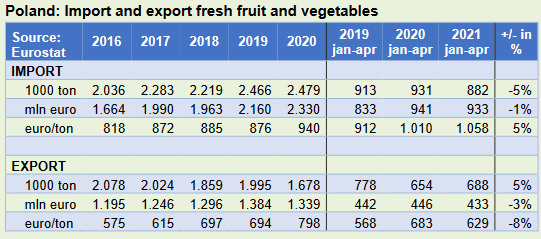
Lots of apples, large full-soil vegetables, greenhouse vegetables
As mentioned, Poland is a large producer. Annually, it produces five million fruits and 5.5 million vegetables. This is the year-on-year production average. It grows three million tons of apples. So, that product is, by far, the most important fruit product. A third of these are industrial apples.
Other fruits are strawberries and sweet and sour cherries. Raspberries, blackcurrants, plums, and pears are included too. Blueberry cultivation is also on the rise in Poland. By now, the country is producing 40,000 tons of these.
The top Polish vegetables are a combination of large full soil vegetables - such as cabbage, carrots, and onions - and protected cultivation, like tomatoes and cucumber. Poland grows almost 700,000 tons of tomatoes and 140,000 tons of bell peppers under cover. In the Netherlands, that is 900,000 tons and 430,000 tons, respectively.
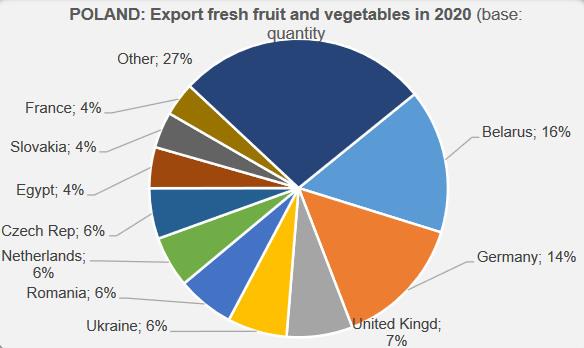
Cabbage is Poland's top product. They cultivate 950,000 tons of these. In the Netherlands, that is 180,000 tons. Poland grows 730,000 tons of carrots (570.000 tons in the Netherlands). And 600,000 tons of onions (1.7 million tons in the Netherlands). Cauliflower/broccoli and beet are the other major products. At 178,000 tons, mushroom production was a lot smaller last year.
Poland cultivates the most raspberries in the European Union. And the fifth-most in the world. It accounts for more than half of total EU production. From 2004 to 2006, Polish raspberry production averaged about 58,000 tons. The total production area during that period was about 16,000 ha.
By 2016, production had grown to 129,000 tons, and the cultivation area to 29,300 ha. Poland's raspberry acreage is fairly stable. However, the harvest varies from year to year. That is due to changing weather conditions.
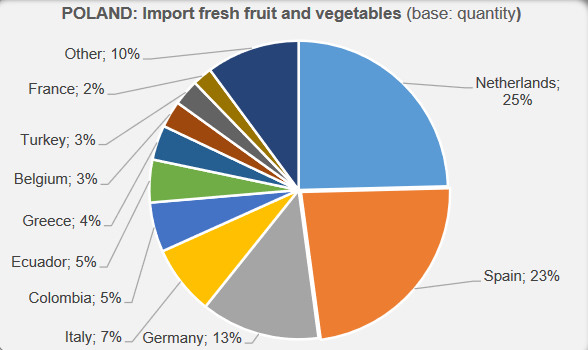
The Netherlands is a top supplier; particularly re-export
In 2020, Poland imported as much fresh fruit and vegetables as in 2019 - 2.5 million tons. It was more than the years before, though. Bananas were, by far, the most important product. Last year, Poland imported 560,000 tons of these. In the three previous years, it was 450,000 tons.
That fell considerably in early 2021. Tomatoes, watermelons, mandarins, oranges, and onions followed. Imports from the Netherlands consist largely of re-export. Bananas are the top product that ends up in Poland. That is from (via) the Netherlands.
Last year, according to Eurostat, that involved a re-export of over 130,000 tons. Onions are the second most important product. Poland imported 122,000 tons from the Netherlands in 2020. Tomatoes, pears, oranges, lemons, carrots, and grapes from the Netherlands follow. As do many other products.
In total, 25% of all of Poland's imports come from/via the Netherlands. That is to say, 610,000 tons. The Netherlands exported 130,000 tons of locally-grown fresh vegetables and fruits to Poland last year. So says the Dutch Quality Control Bureau and the Fresh Produce Center.
Imports from Spain totaled 576,000 tons. That was less than in 2019 but more than before. Spain exports mainly citrus to Poland. Last year that was 82,000 tons of mandarins, 70,000 tons of oranges, and 60,000 tons of lemons. Tomatoes and bell peppers follow.
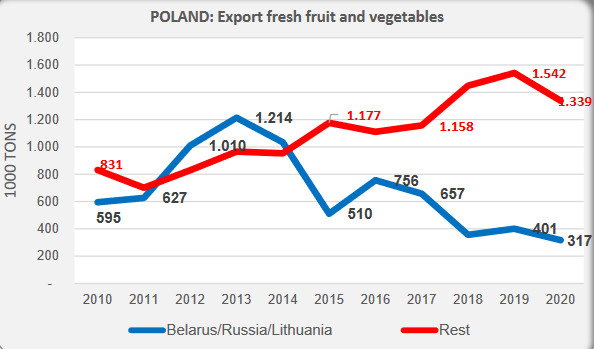
Export countries
Russia used to be a tremendously important sales market for Poland. At its peak in 2013, Poland exported 1.2 million tons of fresh fruits and vegetables there. That included Belarus and Lithuania. Last year, that was only 317,00 tons. Here, Belarus was still vital, with exports of 262,000 tons. Germany buys the second-most Polish produce. In 2020, it took 240,000 tons. This was more than in 2019 but less than in 2018.
The United Kingdom was in third place with 120,000 tons. That was significantly less than in previous years. At the beginning of this year, exports to the United Kingdom rose slightly. Ukraine and Romania, and then the Netherlands followed. Exports to the Netherlands have fluctuated between 75 and 110,000 tons in recent years. What is unusual is that onions are the most important product that the Netherlands buys from Poland.
Export: mostly apples
Polish exports rely heavily on apples. With 645,000 tons, this product represents almost 40% of total fresh fruit and vegetable exports. After Belarus, Egypt is the second-largest buyer of Polish apples. In 2020, they took 75,000 tons, and in 2019 almost 130,000 tons.
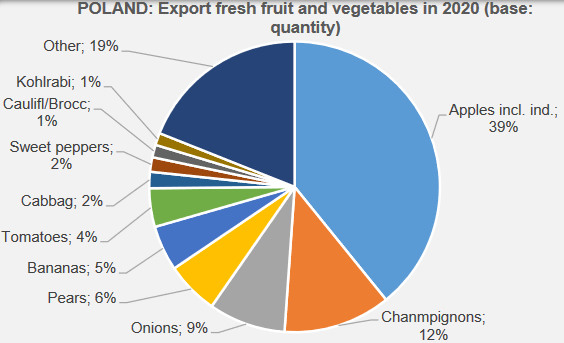
Polish mushroom exports peaked in 2018 at a whopping 235,000 tons. In 2019, that was 212,000 tons, and in 2020, 200,000 tons. In early 2021, more mushrooms were exported, however. That recovery did not apply to this product's most important sales market, the United Kingdom. This year, exports to that country declined further. In the whole of 2020, Poland exported 50,000 tons of its mushrooms to the UK. In the two previous years, it was over 54,000 tons.
Germany is the other major Polish mushrooms buyer. France is at number three. And, far behind, a string of other countries follows. Poland exports quite a lot of onions. In 2020, it was 211,000 tons. Of this, 60,000 tons went to the United Kingdom, and 57,000 tons to the Netherlands. Polish pear exports amounted to almost 100,000 tons. Most went to Belarus. At the beginning of this year, exports of Polish pears to that country again increased.
Lots of processed produce
In Poland, a lot of, especially, fruit goes to the processing industry. Much of that, in turn, goes across the border. Apple juice is an important export product. A lot of frozen fruit, too, is exported. Frozen vegetables are also an important export product. And the country exports a lot of mushroom preserves and dried vegetables.
Click here for the complete analysis (in Dutch).
For more information:
Jan Kees Boon
Fruit and Vegetable Facts
Email: fruitvegfacts@gmail.com
Website: www.fruitandvegetablefacts.com
